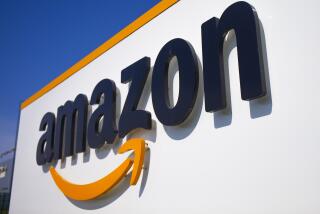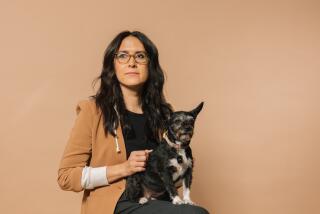Don’t think of Amazon Echo as just a speaker. It’s a whole new way of life

The Amazon Echo is turning regular homes into smart homes.
Reporting from San Francisco — Stephanie Palermo wasn’t interested in living in a “smart home” outfitted with web-connected appliances controlled remotely by phone or computer. She didn’t need her fridge to have Wi-Fi or her blinds to close themselves.
But when Amazon temporarily discounted its voice-controlled Echo speaker to $99 for Amazon Prime members, there was “a low barrier to entry,” and the 28-year-old from Belmont, Calif., was willing to take a risk.
She started using the cylindrical device as a hands-free speaker. Then as a kitchen timer and weather checker. During board game nights, she’d tell Alexa — the artificial intelligence that powers the Echo — to play themed music from Pandora. She’d ask it trivia questions too.
“We use it every day,” Palermo said. “She … it’s also weird I just called her a she!”
This is how smart home adoption will start, according to tech experts, who see lower-end devices such as the Echo and Google Home as important bridges for the average consumer between today’s “dumb” homes and a Jetsons-like future. With tech firms and appliance makers betting that everything in our homes eventually will get connected, the key, analysts said, is to help consumers feel comfortable with the idea now so they can be nudged along to make bigger investments in the future.
“The Echo is the smart home Trojan horse,” said Patrick Moorhead, principal analyst at Moor Insights and Strategy. “You bought it to do a few simple things and be a speaker, then they get you comfortable and send you weekly updates to let you know what you can do with it and ultimately once you go out and get those smart lights or smart door locks, you will be comfortable telling it to do things.”
That was the case for Erik Keto, 35, from New York, who picked up an Echo because he was in the market for speakers, and ended up buying Echo-compatible smart plugs, which let him turn off devices remotely, and Echo-compatible lightbulbs.
“It definitely is a gateway,” said Keto, who, like Palermo, also uses the Echo to check the weather, get news updates and now, turn things off and on throughout his house.
Appliance makers recognize the role home assistants like the Echo play in easing customers into connected living. In one sense, it’s a discovery tool, helping users learn about tech they can try that’s compatible with their virtual assistant.
“If you’re looking to buy a TV, you can go to Fry’s and choose from a few brands that everyone knows,” said Ankush Tiwari, chief technology officer at software engineering firm Mobiliya. “Today, if a consumer wants a connected home, where do they go?”
Honeywell, the multi-national conglomerate best known for its home air filters and humidifiers, believes its partnerships with the Amazon Echo and Apple’s HomeKit have helped it reach customers who might otherwise not know that the company also sells connected devices such as Wi-Fi-enabled thermostats and water-leak detectors.
“It’s nice because the Echo is something people use every day, and through it, you learn about more smart devices,” said Sandhya Rao, senior director of product development at Honeywell. “Every month, you might be adding new devices, and over a year or so, your life might look very different.”
Though Amazon says it has already sold millions of Alexa-enabled devices, widespread adoption won’t happen until there is some form of standardization, tech experts said. Today, smart home technology exists within walled gardens; some devices connect only with Alexa, some with HomeKit, others connect to neither and rely on proprietary controls.
“The practical limitation is you need the software program that lets things talk to each other,” said Chuck Huebner, chief executive of Dacor, a high-end kitchen appliance maker in the City of Industry that Samsung acquired in August. “[Software] that lets Echo talk to Dacor things, or Dacor things talk to Nest,” he said. “How these things connect is not trivial.”
Even if that technological hurdle was overcome, device makers such as Amazon, Apple and Google would have to be willing to work together, which, in the near-term, at least, is an unlikely prospect given that they each want to draw users into their own ecosystems.
Amazon wants to know what customers are buying, and it hopes its home devices make purchases so seamless that it becomes their default retailer for everything around the home. Google wants to know what users are asking so it can learn more about their habits and interests — helping it better serve them with advertising. Apple wants to keep customers hooked on its operating system so they keep buying Apple products.
When it all connects, though — Moorhead pegs it at two to three years away — and it’s as easy to set up as bringing an Echo into the home, that’s when connected living will really take off, Moorhead said.
For now, Palermo is content with having the Echo sit on her kitchen counter, automating just a handful of things.
Keto is also happy using his Echo primarily as a speaker that plays music and reads the news. “[But] I might start collecting more bulbs,” he said. “It’s nice to turn on the lights with your voice.”
Times staff writer Shan Li contributed to this report.
Twitter: @traceylien
MORE BUSINESS NEWS
Your tax dollars at work: $5 bribes to take a government survey
Classic cars share space with furniture, paintings in ‘Art of the Bugatti’ at Petersen
Takata air bag blamed for woman’s death in Riverside County crash last month







